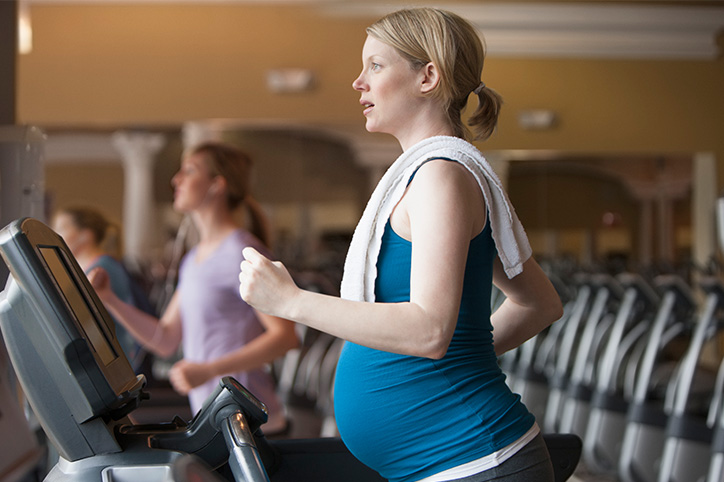When I was pregnant I was wishing and hoping I’d give birth at 39 weeks, so I basically started doing everything I could at 37 weeks – when I was told (erroneously) that the baby was already 6 1/2 lbs – to see if I could help get the party started. In the end I delivered at 41 weeks – two days before a scheduled induction. Labor started for me around midnight after having a membrane sweep done that morning. My personal experience would suggest it helped, but what about the other things I tried in the preceding weeks?
“There’s actually very little data to prove many of the old wives’ tales to induce labor work, despite many being around for centuries,” says Dr. Jennifer Lincoln, OB-GYN and author of LET’S TALK ABOUT DOWN THERE: An OB-GYN Answers All Your Burning Questions without Making You Feel Embarrassed for Asking. “The good news is that most are probably safe to try, but you shouldn’t feel any guilt in skipping some or all of them – babies tend to be born when they are ready!”
We took a deeper look at some popular natural ways to “induce” labor and ask Dr. Lincoln her thoughts.
Raspberry leaf tea
“The use of raspberry leaf tea in a medical way has been around for centuries, and many pregnant people are told by their friends to take it to help stimulate or shorten labor. Unfortunately, we have very weak evidence investigating these claims and the evidence that we do have does not show that it helps to naturally induce labor. It may not be harmful to take, but if you’re wanting to limit exposure to any herbs or products where we don’t have robust safety data, then you may want to skip it.”
Membrane sweep
“Out of all the membranes listed here, this is the one that has strong science to support it. We know that membrane sweeping (also called membrane stripping) has been shown to increase the likelihood you will go into labor within 48 hours. Your obstetric provider will do a vaginal exam and take one finger and sweep it around the inside of the cervix to help separate the bag of water from the lower uterine segment. In response your body release prostaglandins, which can help soften the cervix and cause uterine contractions. It can be crampy or uncomfortable and your cervix needs to be dilated a little in order for your provider to do this (please don’t try this at home!). In general we don’t recommend this until 39 weeks gestation since it’s best to let baby develop until then, but the good news it can be repeated if it doesn’t work the first time.”
Exercise/walking
“Walking and exercise are great in pregnancy as we know people who exercise regularly in pregnancy have faster labors and higher rates of vaginal births. What we don’t have, however, is any data to support it when it comes to putting you into labor. By all means, get out there if it feels right for your body, but stay hydrated and don’t feel that you need to do a marathon – you don’t need the extra exhaustion!”
Sex
“It has long been said that having sex can bring on labor, but we have no good data to support or refute this. The potential way this works is two-fold: orgasm releases the hormone oxytocin, the very same hormone that causes the uterus to contract and chemicals called prostaglandins are present in semen are known to soften or ‘ripen’ the cervix. If you are up for having sex and want to see if that helps put you into labor, go for it, but don’t do it because you feel obligated or think it’s a guarantee that labor will begin.”
Spicy food
“Again we have no data to show whether or not this helps with causing true labor, but it’s probably not harmful – other than the possible GI upset – so only eat it if it sounds appetizing.”
Castor oil
“We only have very small studies about the use of castor oil in labor induction and as such there isn’t enough evidence to say whether or not this old wives’ tale works to bring on labor. What we do know, however, is that in those same studies the one consistent side effect of taking castor oil is nausea. You may want to skip it for that reason alone.”
Acupuncture
“No trials support acupuncture or acupressure for labor induction – either doing it once or throughout your entire pregnancy. There is some data that showed that acupuncture may help soften the cervix, but we haven’t seen that translate into helping with the onset of labor. There is likely very little harm to doing this however, and it can be relaxing, but practitioners who advertise it as a way to put you into labor are overstating their claims a bit.”
Nipple stimulation
“Either by using a pump or your hands, stimulating the nipples leads to oxytocin release, which can result in uterine contractions. In people who did this and who’s cervices were already a little dilated, nipple stimulation did make a difference. Please don’t do this before 39 weeks or if you have any high risk conditions, and checking with your obstetric provider before you try this is probably a good idea.”




